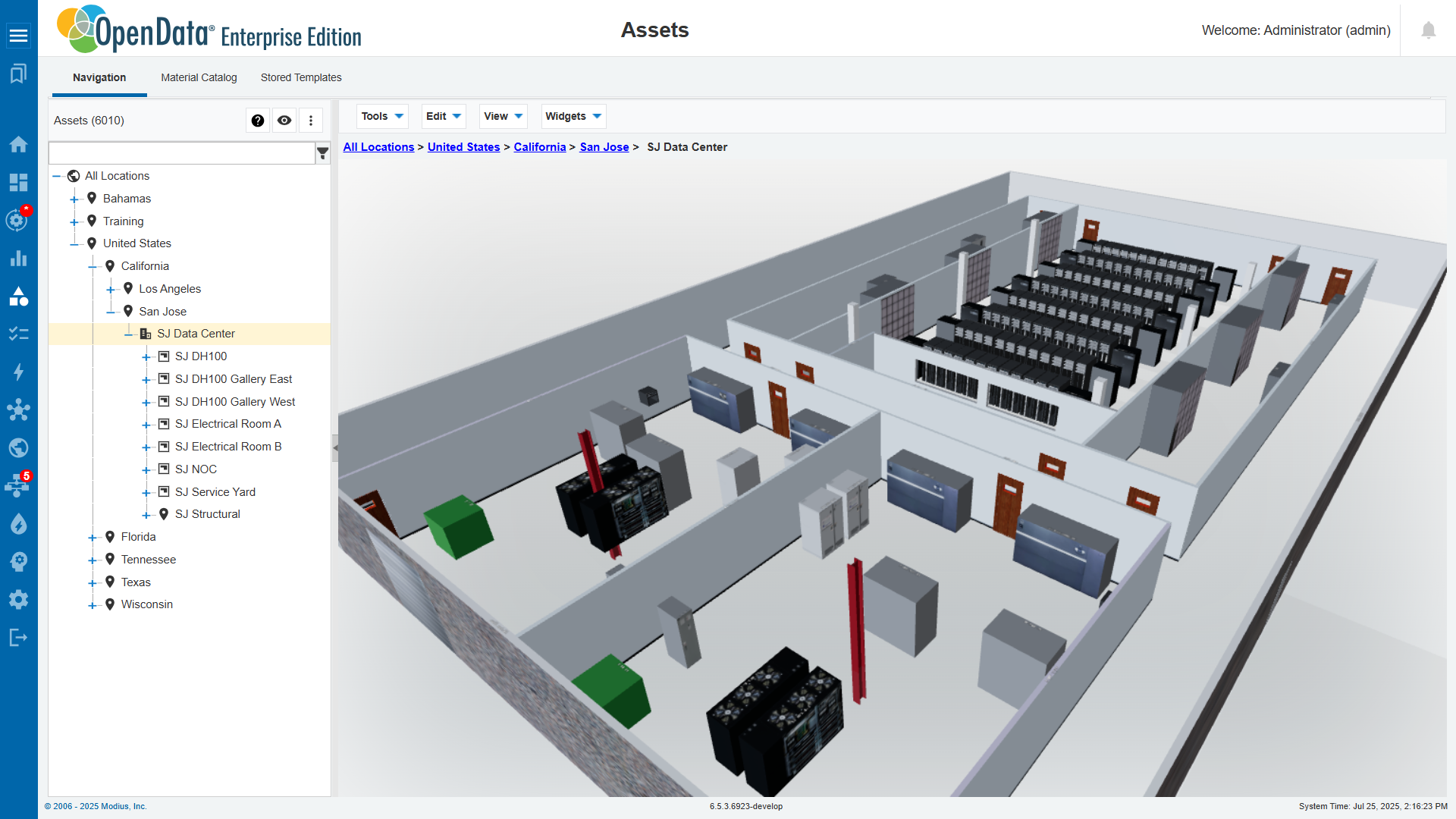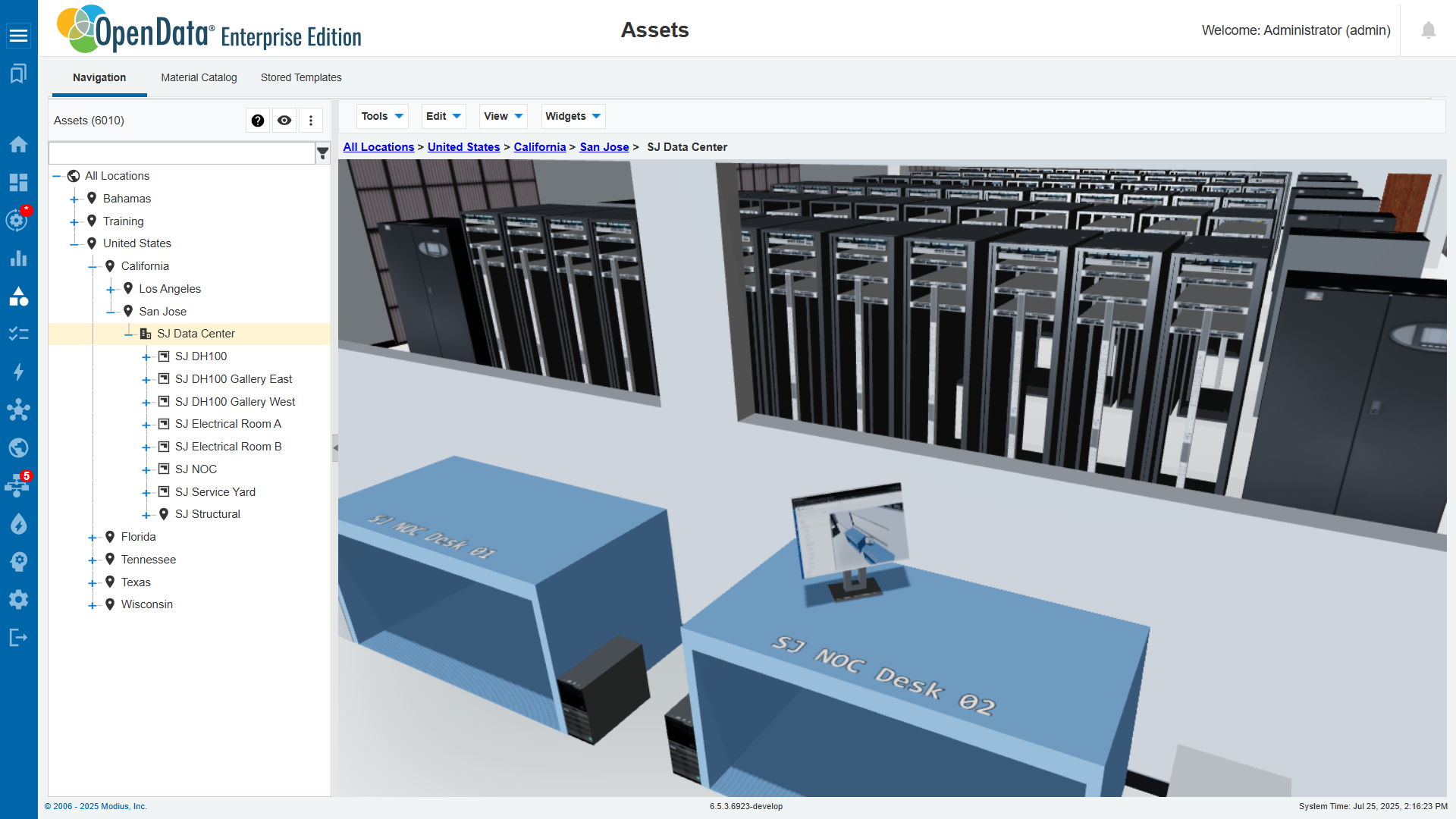Managing assets across a data center is more complex than ever. From tracking devices to modeling lifecycle data, operators need tools that give them full visibility and control. That’s why Data Center Infrastructure Management (DCIM) has become essential. Modius® OpenData® delivers a complete DCIM software solution that simplifies and strengthens how data centers manage their infrastructure.
In this blog, we’ll walk through key asset management capabilities built into OpenData and how they support better data center management.
Why DCIM Software Matters for Asset Management
Traditional spreadsheets and siloed tools no longer cut it. As data centers grow in density and complexity, operators need centralized platforms that can:
- Track thousands of diverse assets
- Maintain clean and accurate asset inventories
- Visualize locations, power paths, and network connections
- Support lifecycle planning and compliance audits

OpenData, our enterprise-grade DCIM software, does all of this with an intuitive, scalable architecture that supports hybrid environments, whether they are on-premises or cloud.
Complete Asset Type Coverage
OpenData can track virtually any asset type in your environment.
- The platform supports physical, virtual, and logical assets.
- It integrates vendor-neutral data, so you’re not locked into a specific ecosystem.
- All asset types can be modeled and extended as needed, ensuring long-term adaptability.
This level of flexibility is critical for teams managing dynamic environments, especially those supporting colocation, hyperscale, or edge computing models.
Flexible Asset Modeling
OpenData allows you to model assets with real-world relationships.
- Assets can be nested inside other assets, like a blade server within a chassis.
- You can link logical systems to physical components, allowing for more intelligent impact analysis.
- The software supports custom views based on how you want to manage your data center.
OpenData also supports full visibility into sub-assets, allowing you to track components like line cards, GPUs, or SSDs independently across their lifecycle. This level of granularity is increasingly critical as individual components can carry six-figure price tags and require the same level of oversight as full systems.
These detailed asset models lay the foundation for digital twin strategies, enabling a true real-time representation of your environment by merging live data with accurate asset characteristics and spatial location.
By supporting advanced modeling, OpenData helps operators see how changes affect their systems across power, network, and cooling domains.
Detailed Asset Data by Default
A strong DCIM platform tracks existing assets and captures key information for each one.
- OpenData automatically tracks manufacturer, model, serial number, and other core identifiers.
- It logs power and network details, location history, and maintenance data.
- You can extend these fields through custom attributes and metadata.
Having all this information at your fingertips helps data center teams move faster when troubleshooting, planning capacity, or responding to audits.
Asset Lifecycle Management
Tracking lifecycle stages is key to smart asset planning.
- OpenData allows you to assign states such as Planning, Deployed, and Retiring
- Operators can visualize asset age, utilization, and replacement timelines.
- You can filter views by lifecycle state to streamline upgrades or refreshes.
With this capability, teams can avoid surprise failures and manage CAPEX more strategically.
Custom Fields and Metadata
Every data center is different, and your DCIM software should reflect that.
- OpenData supports unlimited custom fields for any asset.
- You can configure these by asset or location.
- The platform makes it easy to tag and search based on user-defined criteria.
This means you can tailor the system to match your operational processes, without relying on workarounds.
Role-Based Security
Not every stakeholder needs the same level of detail.
- OpenData enables control over what data a user or user group sees, by location or even down to the individual asset.
- Operations teams can see rack-level details, while executives may prefer high-level dashboards.
- These views are configurable and can be saved, shared, and reused.
By customizing what each team sees, OpenData improves collaboration without overwhelming users with unnecessary data.
Location Awareness and Hierarchies
Understanding exactly where assets live in your data center is a must.
- OpenData supports multi-level location hierarchies, from global sites to individual rack units.
- You can track moves, additions, and changes with full audit history.
- The system can also display capacity and utilization
This makes it easier to balance workloads, optimize space, and plan expansions.
Modeling Asset Connectivity
Your assets don’t operate in isolation. OpenData helps you track how everything is connected.
- The software records both power and network paths.
- You can trace a server’s connection from its NIC to the top-of-rack switch to the core network.
- It also tracks power chains from devices to PDUs and UPS systems.
This level of visibility is vital for incident response and change planning in high-uptime environments.
Visualizing Rack and Floor Assets
Clear visuals make it easier to manage dense environments. OpenData delivers this with dynamic renderings.

| Visualization Feature | Benefit |
| 3D Floor Plan Views | Quickly identify assets by location |
| 3D Rack Elevation Diagrams | See front and rear asset positions |
| 3D Interactive Navigation | Drill into asset details directly from visuals |
These tools help technicians save time during installation and troubleshooting while also improving planning accuracy.
Dynamic Asset Visualization
OpenData delivers detailed visuals that keep your asset information accurate and easy to understand.
- Accurate Hardware Layouts: See nested assets like blade servers in chassis and PCI cards in servers, fully represented.
- 3D Views: 3D visuals for easier inspection and planning.
- Port and Connector Details: Visualize all ports and connectors to understand power and network connections clearly.

By fully supporting these visualization features, OpenData helps your teams manage and troubleshoot assets faster and with more confidence.
Clearer Floor Plans
OpenData offers comprehensive floor plan visualization to give you full insight into your data center layout.
- Full Fly-Through 3D Displays: Explore your data center in immersive 3D, including all floor assets, rack-mounted equipment, and every sub-asset like slots.
- Complete Asset Visibility: Every component is represented, ensuring nothing is overlooked in your planning or operations.
By fully meeting these requirements, OpenData provides powerful visualization tools that enhance spatial awareness and operational efficiency.
Powerful and Flexible Asset Search
OpenData makes finding assets fast and intuitive with a robust search interface:
- Simple Matching: Search by name, asset ID, serial number, or type instantly.
- Advanced Rule Builder: Create complex, hierarchical filters using any system or custom attribute, and select the matching results in the 3D display.
- Resource-Based Search: Filter assets by available power, connections, rack space, and more.
- Comprehensive Filtering: Use any combination of attributes, system or custom, to narrow down results precisely.
This flexible search capability lets your team quickly locate the right assets, saving time and reducing errors.
Planning Asset Reservations (Capacity Planning)
OpenData lets you reserve space and resources for assets before they arrive:
- Define reservations with lifecycle states like “planning” to model future assets.
- Reserve power, rack space, cooling, and position to ensure availability when deploying.
- All lifecycle changes and attribute updates are logged and visible in asset history.
- Reservation data feeds advanced analytics and reporting for better planning.
This capability helps prevent resource conflicts and supports smooth asset deployment workflows.
Full Visibility into Project Status
OpenData lets you track project progress at every level with flexible status management:
- Assign project status to any asset using customizable dropdown attributes.
- The Planning module tracks the overall project status as well as each individual step.
- This granular tracking provides clear visibility into infrastructure changes and progress.
- Reporting tools surface project updates for better decision-making.
With OpenData, managing complex infrastructure projects becomes transparent and efficient.
Enforcing Consistent Naming Standards
OpenData helps maintain clean and consistent asset names across your data center:
- Validates asset names against customizable naming formats.
- Identifies non-compliant assets and generates reports for easy remediation.
- Supports exporting results to streamline renaming efforts.
This ensures naming consistency, improves data quality, and simplifies management.
Streamlined Asset Management with a Flexible Catalog
OpenData offers a comprehensive Asset Master Catalog with pre-designed templates from major manufacturers.
- Choose only the templates you need to keep your catalog clean and manageable.
- Easily create new asset templates within the user interface if they aren’t already available.
- Reference asset masters when adding devices to floor plans or cabinets for consistency.
- Override template attributes at the individual asset level when necessary.
- Updates to asset masters automatically apply to all linked assets unless they are overridden, enabling powerful global changes.
This flexible catalog system speeds asset creation and ensures consistent, up-to-date data across your infrastructure.
Designed for Scalability and Compliance
Whether you manage a single facility or a global portfolio, OpenData scales to meet your needs.
- It supports high-volume asset environments with real-time updates.
- OpenData logs changes, user actions, and historical data for full audit readiness.
- Built-in compliance features support regulatory reporting and best practices.
- For teams tasked with securing uptime, reducing risk, and proving compliance, OpenData delivers what matters most.
The Takeaway
DCIM software like OpenData gives data center teams the tools to move from reactive management to proactive control. From asset modeling and tracking to lifecycle planning and visualization, Modius makes Data Center Infrastructure Management smarter, simpler, and more scalable.
We are passionate about empowering our clients to run more profitable data centers while providing unmatched visibility into operational data. Modius has been delivering DCIM solutions since 2007. We are based in San Francisco, are proudly certified for ISO/IEC27001 and are a Veteran-Owned Small Business (VOSB). Contact us at sales@modius.com or (888) 323.0066 to learn more.
Don’t just monitor your infrastructure, master it with OpenData.
Want a closer look? Contact us to schedule a demo or request a free trial.
About the author

Meet Ray Daugherty, a Senior Services Consultant in our Solution Delivery organization with over 42 years of experience in the data center software market. At Modius for more than three years, he’s been instrumental in managing OpenData implementations, including a significant project spanning 11 data centers across four European countries. Reflecting on his career, Ray has seen DCIM evolve from siloed tools focused on basic monitoring to integrated, AI-driven solutions prioritizing sustainability and environmental monitoring. Looking ahead, he’s excited about how AI will shape the industry, driving innovations in workforce automation and cybersecurity, and he aims to help OpenData meet these future demands. A standout feature of OpenData, he notes, is its ability to monitor data at scale in a vendor-agnostic way, providing data center operators with actionable insights. Outside of work, Ray enjoys traveling, board games and card games, and the occasional scuba diving adventure. His expertise, dedication, and zest for exploration makes him an invaluable part of the Modius team.

